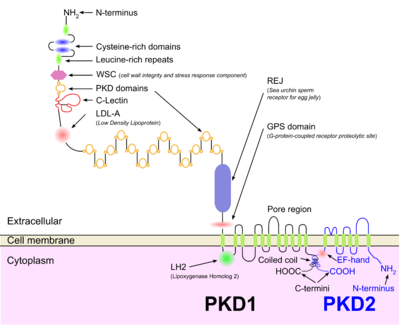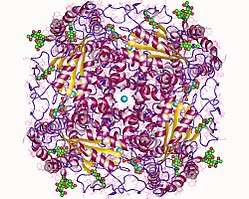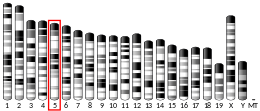Polycystin 2
Polycystin-2 is a protein that in humans is encoded by the PKD2 gene.[5][6]
This gene encodes a member of the polycystin protein family, called TRPP2, previously known as polycystin-2, PC2 or APKD2. TRPP2 contains multiple transmembrane domains, and cytoplasmic N- and C-termini. The protein may be an integral membrane protein involved in cell-cell/matrix interactions. TRPP2 may function in renal tubular development, morphology, and function, and may modulate intracellular calcium homeostasis and other signal transduction pathways. This protein interacts with polycystin 1 (TRPP1) to produce cation-permeable currents. It was discovered by Stefan Somlo at Yale University.

Clinical significance
Mutations in this gene have been associated with autosomal dominant polycystic kidney disease.[6]
Interactions
Polycystin 2 has been shown to interact with the proteins TRPC1,[7] PKD1[7][8] and TNNI3.[9]
References
- GRCh38: Ensembl release 89: ENSG00000118762 - Ensembl, May 2017
- GRCm38: Ensembl release 89: ENSMUSG00000034462 - Ensembl, May 2017
- "Human PubMed Reference:". National Center for Biotechnology Information, U.S. National Library of Medicine.
- "Mouse PubMed Reference:". National Center for Biotechnology Information, U.S. National Library of Medicine.
- Peters DJ, Spruit L, Saris JJ, Ravine D, Sandkuijl LA, Fossdal R, Boersma J, van Eijk R, Norby S, Constantinou-Deltas CD, et al. (March 1994). "Chromosome 4 localization of a second gene for autosomal dominant polycystic kidney disease". Nat Genet. 5 (4): 359–62. doi:10.1038/ng1293-359. PMID 8298643.
- "Entrez Gene: PKD2 polycystic kidney disease 2 (autosomal dominant)".
- Tsiokas, L; Arnould T; Zhu C; Kim E; Walz G; Sukhatme V P (March 1999). "Specific association of the gene product of PKD2 with the TRPC1 channel". Proc. Natl. Acad. Sci. U.S.A. UNITED STATES. 96 (7): 3934–9. Bibcode:1999PNAS...96.3934T. doi:10.1073/pnas.96.7.3934. ISSN 0027-8424. PMC 22398. PMID 10097141.
- Tsiokas, L; Kim E; Arnould T; Sukhatme V P; Walz G (June 1997). "Homo- and heterodimeric interactions between the gene products of PKD1 and PKD2". Proc. Natl. Acad. Sci. U.S.A. UNITED STATES. 94 (13): 6965–70. Bibcode:1997PNAS...94.6965T. doi:10.1073/pnas.94.13.6965. ISSN 0027-8424. PMC 21268. PMID 9192675.
- Li, Qiang; Shen Patrick Y; Wu Guanqing; Chen Xing-Zhen (January 2003). "Polycystin-2 interacts with troponin I, an angiogenesis inhibitor". Biochemistry. United States. 42 (2): 450–7. doi:10.1021/bi0267792. ISSN 0006-2960. PMID 12525172.
Further reading
- Islam, Md. Shahidul (January 2011). Transient Receptor Potential Channels. Advances in Experimental Medicine and Biology. 704. Berlin: Springer. p. 700. ISBN 978-94-007-0264-6.
- Torres VE (1998). "New insights into polycystic kidney disease and its treatment". Curr. Opin. Nephrol. Hypertens. 7 (2): 159–69. doi:10.1097/00041552-199803000-00004. PMID 9529618.
- Deltas CC (2001). "Mutations of the human polycystic kidney disease 2 (PKD2) gene". Hum. Mutat. 18 (1): 13–24. doi:10.1002/humu.1145. PMID 11438989.
- Boletta A, Germino GG (2004). "Role of polycystins in renal tubulogenesis". Trends Cell Biol. 13 (9): 484–92. doi:10.1016/S0962-8924(03)00169-7. PMID 12946628.
- Cantiello HF (2004). "Regulation of calcium signaling by polycystin-2". Am. J. Physiol. Renal Physiol. 286 (6): F1012–29. doi:10.1152/ajprenal.00181.2003. PMID 15130895.
- Everson GT, Taylor MR, Doctor RB (2004). "Polycystic disease of the liver". Hepatology. 40 (4): 774–82. doi:10.1002/hep.20431. PMID 15382167.
- Witzgall R (2007). "TRPP2 channel regulation". Handb Exp Pharmacol. Handbook of Experimental Pharmacology. 179 (179): 363–75. doi:10.1007/978-3-540-34891-7_22. ISBN 978-3-540-34889-4. PMID 17217069.
- Köttgen M (2007). "TRPP2 and autosomal dominant polycystic kidney disease" (PDF). Biochim. Biophys. Acta. 1772 (8): 836–50. doi:10.1016/j.bbadis.2007.01.003. PMID 17292589.
- Andersson B, Wentland MA, Ricafrente JY, et al. (1996). "A "double adaptor" method for improved shotgun library construction". Anal. Biochem. 236 (1): 107–13. doi:10.1006/abio.1996.0138. PMID 8619474.
- Mochizuki T, Wu G, Hayashi T, et al. (1996). "PKD2, a gene for polycystic kidney disease that encodes an integral membrane protein". Science. 272 (5266): 1339–42. Bibcode:1996Sci...272.1339M. doi:10.1126/science.272.5266.1339. PMID 8650545.
- Schneider MC, Rodriguez AM, Nomura H, et al. (1997). "A gene similar to PKD1 maps to chromosome 4q22: a candidate gene for PKD2". Genomics. 38 (1): 1–4. doi:10.1006/geno.1996.0584. PMID 8954772.
- Yu W, Andersson B, Worley KC, et al. (1997). "Large-Scale Concatenation cDNA Sequencing". Genome Res. 7 (4): 353–8. doi:10.1101/gr.7.4.353. PMC 139146. PMID 9110174.
- Qian F, Germino FJ, Cai Y, et al. (1997). "PKD1 interacts with PKD2 through a probable coiled-coil domain". Nat. Genet. 16 (2): 179–83. doi:10.1038/ng0697-179. PMID 9171830.
- Xenophontos S, Constantinides R, Hayashi T, et al. (1997). "A translation frameshift mutation induced by a cytosine insertion in the polycystic kidney disease 2 gene (PDK2)". Hum. Mol. Genet. 6 (6): 949–52. doi:10.1093/hmg/6.6.949. PMID 9175744.
- Tsiokas L, Kim E, Arnould T, et al. (1997). "Homo- and heterodimeric interactions between the gene products of PKD1 and PKD2". Proc. Natl. Acad. Sci. U.S.A. 94 (13): 6965–70. Bibcode:1997PNAS...94.6965T. doi:10.1073/pnas.94.13.6965. PMC 21268. PMID 9192675.
- Hayashi T, Mochizuki T, Reynolds DM, et al. (1997). "Characterization of the exon structure of the polycystic kidney disease 2 gene (PKD2)". Genomics. 44 (1): 131–6. doi:10.1006/geno.1997.4851. PMID 9286709.
- Veldhuisen B, Saris JJ, de Haij S, et al. (1997). "A spectrum of mutations in the second gene for autosomal dominant polycystic kidney disease (PKD2)". Am. J. Hum. Genet. 61 (3): 547–55. doi:10.1086/515497. PMC 1715954. PMID 9326320.
- Viribay M, Hayashi T, Tellería D, et al. (1998). "Novel stop and frameshifting mutations in the autosomal dominant polycystic kidney disease 2 (PKD2) gene". Hum. Genet. 101 (2): 229–34. doi:10.1007/s004390050621. PMID 9402976.
- Pei Y, Wang K, Kasenda M, et al. (1998). "A novel frameshift mutation induced by an adenosine insertion in the polycystic kidney disease 2 (PKD2) gene". Kidney Int. 53 (5): 1127–32. doi:10.1046/j.1523-1755.1998.00890.x. PMID 9573526.
External links
- GeneReviews/NIH/NCBI/UW entry on Polycystic Kidney Disease, Autosomal Dominant
- "Transient Receptor Potential Channels: TRPP1". IUPHAR Database of Receptors and Ion Channels. International Union of Basic and Clinical Pharmacology.




